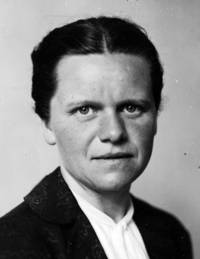


Elisabeth Dane, born in Mayen in 1903, had an extraordinary Career at the Ludwig Maximilian University (LMU) in Munich: she earned her doctorate at the age of 26 despite studying at various universities, her habilitation and venia legendi at 31, her own working group, publications in Angewandte Chemie, lectures, and Editorial staff work for Liebig's Annalen der Chemie. Heinrich Wieland (1877–1957), her patron since her second association examination in 1927, wrote when her habilitation was due in 1933: "Miss Dane... is one of the most gifted students I have trained so far. She possesses an independence and accuracy of scientific thought that I have not encountered in women before... I am of the opinion that women should only be called upon to pursue academic careers in exceptional circumstances, but this is just such a special case."
This was followed by 35 years as a private lecturer and professor of organic chemistry (1939–1968) at LMU Munich, and for 30 years she was responsible for the training of medical students in chemistry. She was the first female professor of chemistry in Munich and one of the first at LMU Munich. Elisabeth Dane had her own working group, was the first bestselling author of the GDCh's Chemistry publishing house, and in 1998, a street in Munich was named after her. And yet, today, hardly anyone in the chemistry community knows her name anymore.
How does something like this happen? One reason is certainly that all the authors of the biographies of female chemists written so far (t1p.de/p9v0z) did not study at LMU Munich; there were simply no personal connections.
If you research the biographies and careers of these pioneering women, you can recognize patterns. For the first phase, a generic, above-average interest in the natural sciences and the openness of an educated home are important. Then male (!) mentors and the development of internal and external networks come into play. In the second Career phase, it is important to continue to "keep up" with research, to embrace new methods and theories together with a committed working group . Working alone with many responsibilities outside of research, you fall behind. Things initially went very well for Elisabeth Dane: Heinrich Wieland, Nobel Prize winner in 1927, recognized her abilities, and she published outstanding works on the synthesis and structure elucidation of complex natural substances, both together with him and on her own. He involved her as a private assistant in many projects, encouraged her independent research, and entrusted her with the training of medical students in chemistry, a task that was so important for the institute.
But then came the second war period for Elisabeth Dane's mentor, Heinrich Wieland. In 1942, his 65th birthday was celebrated; Elisabeth Dane was 39 years old, a bachelor, and the only woman among his large group of students. Her colleague Franz Wille (1909–1986), six years younger than her, wrote about this period, and especially about Elisabeth Dane, when he reflected on his 70th birthday:
...Miss Dane ruled the ground floor. She was the headmaster's earpiece. Difficult institute matters were always discussed with her before they were brought to the attention of the headmaster. We lecturers rarely visited each other back then. But one time, Miss Dane did come; I'll never forget it. It was at 7:30 in the morning; she rang the bell and immediately rushed in. "Wille, you don't need to get up and go to the institute. It's broken." That was in December 1944.
The institute was completely destroyed, the laboratories were relocated, and research and training were maintained only marginally – everyone traveled long distances by bicycle and on the few trains available to communicate with each other. While all male lecturers were dismissed after the end of the war, Elisabeth Dane, who was not a member of the Nazi Party, received permission from the military government on December 18, 1945, to "continue research in the field of vitamin A." But she had little time for this. Her mentor and institute director, who was in poor health, commissioned Elisabeth Dane and his extraordinarily talented "junior student," Rolf Huisgen (1920–2020), who was 17 years her junior, to organize the institute's key tasks, the medical internship, and the rebuilding of organic chemistry. Elisabeth Dane was the only constant for Heinrich Wieland in the postwar years. In 1948, her former colleagues were reinstated, and Rolf Huisgen was appointed to Tübingen in 1949. Elisabeth Dane also received an offer in 1948/1949 – to Rostock; but she declined without (!) demanding negotiations to stay, as she did not want to leave "her physicians and her mentor and colleague Heinrich Wieland" alone during the reconstruction. A successor for Wieland was not quickly found, partly because the institute had been completely destroyed. Several of his students declined; Elisabeth Dane was obviously not trusted to take on this role, and so Rolf Huisgen was finally appointed in 1952. Elisabeth Dane had just turned 50.
Elisabeth Dane had too little time for research and to connect with the new, theory-driven international organic chemistry. She successfully researched the still-young field of peptide chemistry in pharmaceutical chemistry and was perhaps somewhat ahead of her time. Organizing the medical training of 450 students, none of whom were particularly chemistry-savvy, with 15 frequently changing assistants, including the oral examination that was customary at the time, was a Herculean task. Elisabeth Dane became known throughout Germany for this, not least thanks to the book "Kleineschemisches Praktikum" (Small Chemical Practical Course), published in 1960 and still available today, which she co-authored with Franz Wille and regularly updated. Over 400 easily reproducible experiments combined with short theoretical texts made the work, and thus her name, well-known.
In the 1960s, Elisabeth Dane published again at Angewandte and attended international peptide conferences in Oxford and Athens, although these were now primarily organized by biochemistry institutes. However, Elisabeth Dane remained at the Institute of Organic Chemistry because of the medical training offered there. This did not promote Elisabeth Dane's scientific networking. In 1965, a heart attack forced an extended sabbatical and curbed her research enthusiasm, but not her passion for cigarettes. She would have liked to continue working at the institute beyond retirement, but her request was rejected. So she retired to a house she had built and designed herself in Gauting, far outside of Munich's city center. She declined celebrations for milestone birthdays and, at her own request, was buried quietly in March 1984 after a long illness, cared for by her sister.
In his 2023 work on the history of the Chemistry Faculty at LMU, Wolfgang Beck writes about Elisabeth Dane, a colleague of the same age: "Friedrich Klages (also a student of Wieland) belonged to a generation that was skipped in the appointments to professorships as a result of the war and post-war turmoil. This also applies to Elisabeth Dane, Hans Behringer, Rudolf Hüttl, and Franz Wille."
Perhaps a quota would have been helpful for her Career . Her path demonstrates how important it is "to have the right chemistry"—time and again.
This article was published in "Nachrichten aus der Chemie", May 2025
Author: Dr. Eva E. Wille, Chair of the Division of Senior Expert Chemists
Photo: Nachrichten aus der Chemie
back to overview of female chemists' biographies
back to publications
This page has been machine translated. If you have any feedback or comments please feel free to contact us. 
last modified: 29.08.2025 09:05 H from S.Fischer